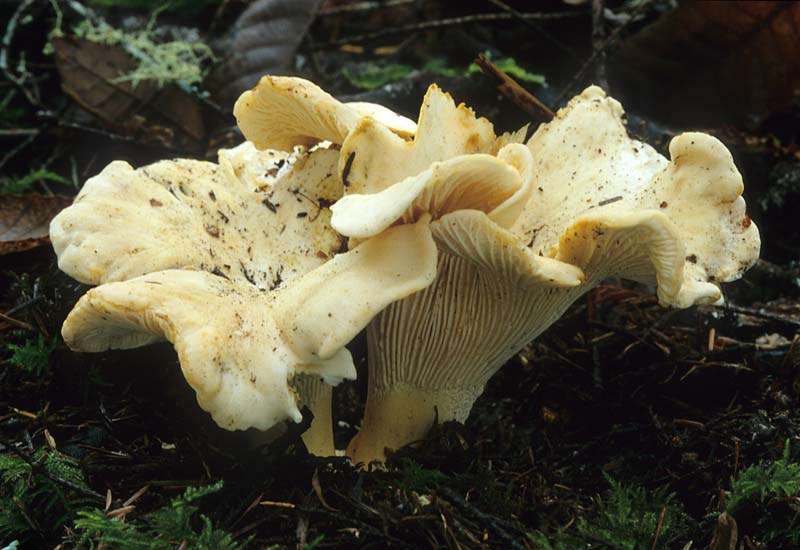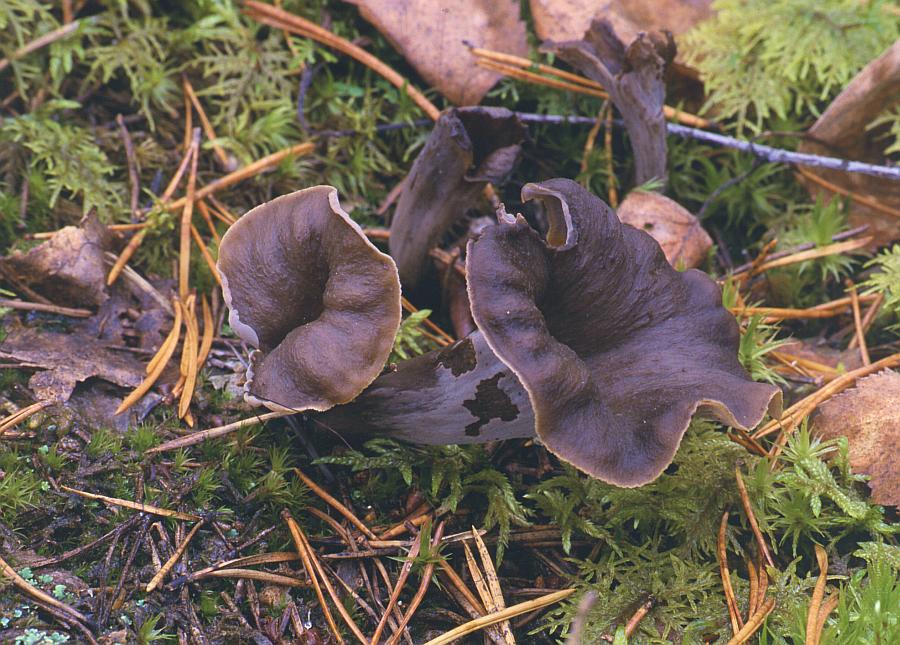Elite life

Mushrooms
Cantharellus
║ Mushrooms ║
Chanterelle, Yellow Chanterelle (Cantharellus cibarius)

Cap: 1-20 cm across; more or less convex when young (often with a rolled-under margin); becoming flat or shallowly depressed, with a wavy and irregular margin; tacky when wet; smooth or with a few tiny appressed fibers; pale yellow to egg-yolk yellow to almost orange.
Undersurface: With well developed false gills that frequently feature cross-veins; running deeply down the stem; colored like the cap or paler; sometimes staining brownish to orangish.
Stem: 3-8 cm long; 1-3 cm thick; extremely variable in shape (from thin, more or less equal, and graceful to thick, stocky and nearly club-shaped); smooth below the false gills; colored like the cap or paler; sometimes bruising brownish to orangish.
Flesh: White; solid; unchanging when sliced.
Yellow Foot, Winter Chanterelle, Funnel Chanterelle (Cantharellus tubaeformis)

Cap: 1-5 cm wide; convex at first, soon becoming vase-shaped and eventually becoming perforated on the center; with a wavy and irregular margin when mature; smooth or somewhat roughened; sticky or waxy when fresh; dark yellowish brown to blackish brown, fading with age.
Undersurface: With well developed false gills that fork frequently and have cross-veins; yellowish gray, becoming brownish.
Stem: 3-8 cm long; to 1 cm wide; more or less equal; becoming hollow; smooth; yellow.
Spores ellipsoid, smooth, 8-12 x 6-10 μm. Flesh: Thin; pale; insubstantial.
Pacific Golden Chanterelle (Cantharellus formosus)

Cap: 2-14 cm; convex with an inrolled margin, becoming broadly convex, flat, or shallowly depressed with an inrolled, uplifted, or irregular-wavy margin; the center not becoming perforated; fairly smooth, finely suede-like, or slightly roughened; bright to dull orange-yellow, with a grayish to brownish pigment layer that is nearly invisible in wet conditions but becomes more prominent with drying or with age in dry weather, appearing as tiny, darker scales; often bruising and discoloring yellowish.
Undersurface: With well developed false gills; pale orange-yellow, with a pinkish cast in most collections.
Stem: 4-8 cm long; to 2 cm thick at apex; usually tapering gracefully downward; more or less smooth; colored like the cap or paler; often bruising yellow near the base; fleshy.
Flesh: Whitish to very pale yellowish.
White Chanterelle (Cantharellus subalbidus)

Pileus: Cap 5-10 cm broad, convex, margin incurved, expanding to nearly plane or depressed at the disc with an uplifted, wavy to irregular margin; surface smooth to appressed squamulose, dry, whitish to cream, bruising yellowish-brown to tawny-brown; flesh thick, whitish, firm, becoming ochraceous to tawny where exposed. Odor and taste mild.
Lamellae: Gills consisting of blunt, anastomosing ridges, well forked near the margin, strongly decurrent, whitish to cream, staining like the pileus when injured.
Stipe: Stipe 2-5 cm long, 2-3 cm thick, fleshy, usually centrally attached, tapering toward the base; surface dry, smooth to somewhat roughened, concolorous with the cap, bruising dull yellow-brown to tawny-brown, especially near the base.
Spores: Spores 7.5-9.0 x 5-6 μm, elliptical, smooth, nonamyloid; spores white in deposit.
Black Trumpet Mushroom, Black Chanterelle (Cantharellus cornucopioides, Craterellus cornucopioides)

Fruiting Body: 2-7 cm wide; up to 10 cm high; tubular at first, becoming deeply vase-shaped; the upper edge rolled under when young and often partly rolled under in maturity; thin-fleshed; without a clearly defined cap and stem.
Upper (Inner) Surface: Black to dark gray (or, rarely, pale yellowish); smooth or, more commonly, roughened or finely scaly with dark fibers and scales over a paler, grayish or grayish brown base color.
Under (Outer) Surface: Smooth or very shallowly wrinkled; rarely with a few deeper folds near the cap margin; blackish (rarely pale yellowish), becoming dusted with the spore color at maturity (salmon tinged, yellowish, or whitish).
Flesh: Thin and brittle; blackish. Spore Print: Salmon tinged, yellowish, or whitish.
║ Mushrooms ║